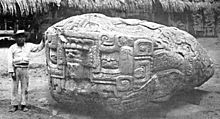
Quiriguá is a Mayan archaeological site in Eastern Guatemala. It is a large, well-explored and documented site that is a ![]() UNESCO World Heritage Site. The site is one of the furthest south of settlements that were part of Mesoamerican cultures. The site is famous for its extremely tall stelae (stone tablets) and its series of zoomorphs (fanciful animal-like sculptures).
UNESCO World Heritage Site. The site is one of the furthest south of settlements that were part of Mesoamerican cultures. The site is famous for its extremely tall stelae (stone tablets) and its series of zoomorphs (fanciful animal-like sculptures).
Understand
[edit]Quiriguá is one of the most historically and anthropologically important Maya sites in Guatemala, yet it is overlooked by most travelers to the region and is far less known that other major Maya sites (like Tikal).
History
[edit]Early Maya settlers arrived in Quiriguá as early as 400 BC, though the oldest structures at the site date from about 200 AD and the site was at its peak between 700-800 AD (which is when many of the structures and stelae that you see now were erected). The architecture and artistic styles at the site are similar to those at Copán and Quirigua was likely a vassal city-state, subordinate to Copan. That evidently changed between 734 and 738 when Quirigua established an alliance with Calakmul and shook off the yoke of subservience pretty forcefully (since the story is that they captured the king of Copan and sacrificed him on top the temple of Quirigua -- yikes -- those Mayan dudes were brutal!)
Their independence didn't last long though. By the year 810 Quirigua was in decline and collapsed by the year 1200, along with most other Maya city-states. No significant buildings or artistic works at the site are dated later than 810.
Landscape
[edit]Climate
[edit]Get in
[edit]By bus
[edit]From the main bus station in Guatemala City Fuente del Norte] operates buses every 2 hours to Quirigua. From Guatemala City, you will likely need to change buses in Rio Hondo and again in Los Amates. The fare will be about US$30.
Fees and permits
[edit]Site entry costs Q80 per adult.
Get around
[edit]See
[edit]

- Site Museum - Near the main road is a good, well-developed site museum with exhibits explaining the site's history and archaeology, as well as displays of smaller relics found at the site.
- Gran Plaza - Plazas in Mayan cities were large open public spaces that would have been used for large gatherings, markets, and similar purposes. Quiriga had one of the largest plazas of the Mayan world, measuring 150 meters wide by 300 meters long. Large stone platforms were built at either end of the plaza. The northern platform (identified on site maps as "1A-1") measured 100 by 85 meters and was elevated half a meter above the level of the plaza itself. The platform was built of river stones and had a paved surface of stone slabs. The northern platform had stelae A, C, D, E, and F and was the site of zoomorph B. The southern end of the plaza had another platform (identified as "1A-3"---those archaeologists can get so creative with names!) The southern platform measured 82-1/2 by 20 meters and was elevated 7 meters above the plaza level and a 63-meter wide staircase provided access via the Gran Plaza. The platform was still under construction when the city dwindled in 810 AD.
- Acropolis - The acropolis is a large palace at the southern end of the city. It was used as residence for royalty and as an administrative center. It was built over time between 550 and 810. The acropolis consists of many distinct structures including the remains of some corbel arches, though no standing arches remain.
- K'inich Ahau Wall - Free-standing wall that was 23 meters long and 1-1/2 meters thick. The wall features mask mosaics of the sun god and snakes with human arms. The wall was completed in 750 AD.
- Original Ballcourt - When archaeologists excavated around the acropolis, they discovered an entire ballcourt that had been buried when the western platform was built. The original ballcourt dates to about 650 AD and was built using the ballcourt of Copan as a model. It has the same design, orientation, and dimensions.
- Ballcourt Plaza - the "new" ballcourt is unusual among Maya cities in that it is oriented east-west while most others have a north-south alignment
Stelae, zoomorphs and various small structures are found throughout the site grounds. Several mounds around the site have not yet been excavated. Some are quite large and probably will reveal pyramid temples when archaeologists dig in to reveal their secrets.
Do
[edit]Buy
[edit]Eat
[edit]Drink
[edit]Sleep
[edit]The closest place to find a room for the night is in the nearby town of Los Amates. There are also a couple hotels on the south shoare of Lago Izabal and a larger selection of lodging choices in the town of Rio Dulce.
There is no established campground near the archaeological site.
- 1 Posada Quiriguá, Aldea de Quirigua, Los Amates. Rustic lodge in a garden setting. The Japanese owner cooks Japanese meals for his guests.
- 2 Hotel Royal, Calle Principal Quirigua, ☏ +502 5715 2810. Basic barebones accomodations with minimal amenities (like no hot water). Q150.
